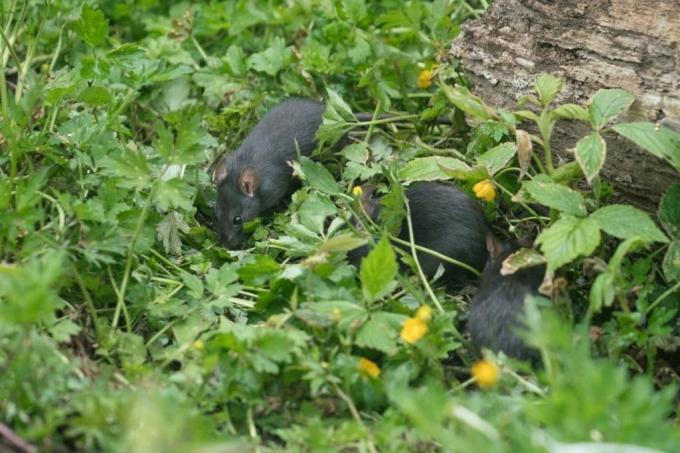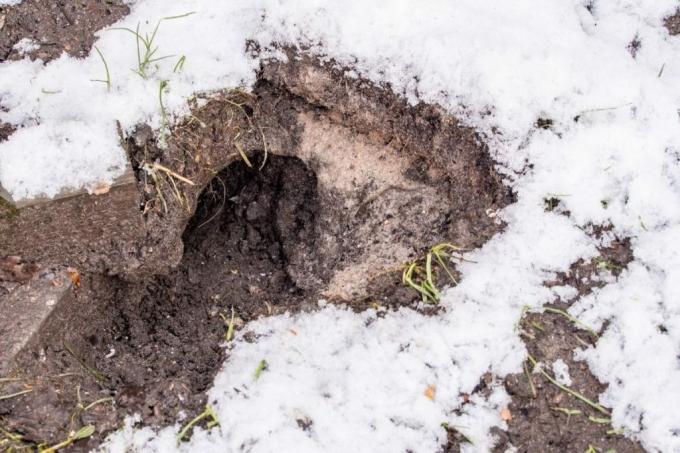
table of contents
- Rodents are nocturnal
- Detect rat infestation
- Holes and nests
- Walkways
- Feces and urine
- Gnaw marks
- Drive away rats
- Fight effectively
- Prevent rat plague
- frequently asked Questions
Rats are intelligent rodents. They belong to the cultural followers of humans and appear increasingly in their vicinity. The animals are usually out and about at night, but sometimes they are also visible in broad daylight.
In a nutshell
- Rats are very intelligent and capable of learning
- they are shy and usually nocturnal
- sometimes they are often looking for food during the day
- a rat plague is notifiable and must be combated
- Distributing fragrances
Rodents are nocturnal
Rats are very clever, docile, but also shy and suspicious animals with a very sensitive nose. As a rule, they are active at night and avoid contact with people. The rodents can multiply rapidly in a short time and a plague of rats can easily occur. Then there is the possibility to see the animals during the day. They are then often on the lookout for food, but mostly only a fraction of the rodents are visible. A garden offers a lot of opportunities to get food. By the way, there are countless hiding spots here and contact with natural enemies such as buzzards or owls is quite rare. Brown rats (Rattus norvegicus) mainly frolic in the garden. House rats (Rattus rattus) prefer warm, dark places in the house.

Note: Rats can transmit over 120 dangerous diseases. In the Middle Ages it was mainly the plague, dysentery and cholera. In addition, diseases such as toxoplasmosis and the transmission of the life-threatening hantavirus infection are also included.
Detect rat infestation
There are various indications for recognizing a rat infestation in the garden. Of course, the presence of the rodents during the day already indicates this. It can normally be expected that where a rat appears, there will be several more. The emergence during the day are the first signs of little food or food. the rat population has already grown in size. A rat clan can quickly contain up to a hundred animals and more. In addition to visible rats during the day, attention should be paid to other indications such as:
Holes and nests
Rats mainly occupy earthworks with at least two entrances. These are round and 3 to 5 cm in diameter. Holes are often found:
- at a few intervals on the walls of sheds and garages
- along the edge of terrace stones
- in the bottom or lids of compost bins
- between tree and bush roots
- next to covers of drains

Walkways
The rodents can smell excellent, but see poorly. Therefore, they always use familiar paths. There are real trails:
- on garden paths, along walls
- narrow, well-trodden paths
- clear seal of approval
- Front paw with four toes
- Hind paw with five toes
- Middle toe extra long
- Dragging trace of the tail between footprints
Feces and urine
- strong smell of ammonia
- brown to black-brown
- Brown rat: in a heap, 1 to 2 cm in size
- Black rat: spread out over an area, 0.5 to 1 cm in size
- fresh droppings shiny black

Gnaw marks
The animals have strong teeth. The teeth keep growing. Therefore, they gnaw even when they are not hungry. Typical of the gnaw marks are parallel grooves. Hardly any material is spared.
Note: According to Section 2 of the Infection Protection Act, rats are considered to be dangerous health pests. In Germany, there is an obligation to report a rat infestation, also for rats in the garden.
Drive away rats
The mourning resp. Driving away the rodents is one of the more gentle measures to get rid of the pests. The rodents are extremely smart and learn from their mistakes. Therefore, they can also adapt very quickly to new conditions. This also makes driving away the animals more difficult. Various home remedies can be used here. Their effectiveness is limited, however, as the animals can quickly get used to it. These include various fragrances such as:
- Ammonia water
- diesel
- turpentine
- Mint and Clove Oil
- Neem oil
- citric acid

These products contain odors that are unpleasant for the rodent. These liquids are simply soaked in rags and then laid out near the whereabouts. However, regular renewal is necessary as the effectiveness only lasts for a few weeks.
Many garden owners also swear by the following home remedies
- used cat litter filled in air-permeable bags
- Chili or pepper powder
- Green salt (iron vitrol)
- Use of ultrasound equipment
- Lime paint on walls
It can be helpful to use these remedies alternately, as the animals quickly ignore the smell.
Note: Rats are also active in winter, but eat less and are therefore not out and about as often during the day. They then look for warm hiding places in sheds, animal stalls or gazebos.
Fight effectively
If a whole clan of these pests haunt the garden, gentle remedies are hardly enough to deter them. Sharper guns must then be deployed to put an end to the plague for good. These measures include:
Alive - and snap traps
Live traps are animal friendly. The rodent can then be released again at another location, which should be at least one kilometer away. However, this shifts the plague of rats to this place. The animals are killed by snap traps. Regarding the application it should be said:

- set up on walkways
- safe from pets and children
- Cheese, bacon, sausage, peanut butter as bait
- check every 8 to 12 hours
- Thorough cleaning after use
Snap traps and the bait should not be set up for a few days so that the animals can get used to them.
Rat poison and poison bait
In the case of a full-blown rat plague, the only thing that can really help is laying out rat poison. It should be noted:
- never interpret freely
- inaccessible to children and pets
- Use of lockable bait boxes
- daily check
- top up first when empty
- Use preparations with chlorophacinon, sodium wafarin or coumatetralyl
- Contact exterminator if necessary

Natural predators
Especially when there are natural predators on the property, the rodents can no longer move safely. Sometimes a dog or a cat is enough. Further measures in this regard can be:
- Nest boxes for hanging owls
- Leave mixed hedges and cairns for martens
- Set up lookout points with perches for hawks and buzzards
Prevent rat plague
Prevention is always better than fighting a plague of rats. It doesn't even take that much:
- Keep order and cleanliness
- do not put leftover food or kitchen waste on the compost
- Mix the compost well
- optimal use of closed quick composter
- collect windfalls regularly
- Clean animal stalls regularly
- Do not leave food residues outside or in the stable
- Keep animal feed and other supplies closed
- Clean places at bird feeders daily
- ideal attachment of special cuffs to feeding places
- Close garbage cans tightly
- do not put leftover food in the toilet
- belong in the trash
- Remove hiding places such as piles of wood, construction waste, other rubbish
- Close loopholes in the house, gazebo, garage
frequently asked Questions
Brown rats are usually up to two years old and house rats are much older. They can reach the age of 12 years. A female can bring between six and eight litters per year with up to eight cubs per litter.
These animals are nocturnal and shy, even if they are sometimes visible during the day. You are not looking for contact with people. However, if cornered, an attack is possible.
No, private individuals are not allowed to use any type of rat poison unless they are suspicious. For this, a rat infestation must be determined. However, exterminators can carry out permanent baiting in exceptional cases.



